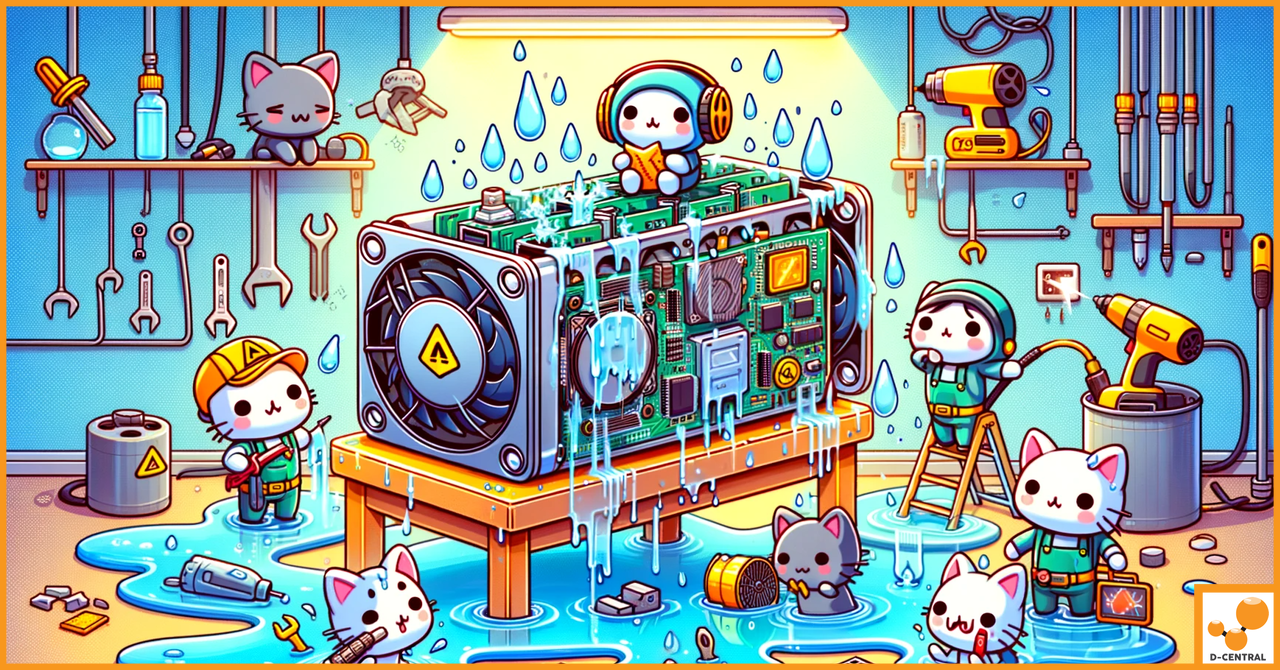
Fixing Water-Damaged ASICs: Proven Tips and Strategies
In the dynamic world of cryptocurrency, Application-Specific Integrated Circuits (ASICs) represent the pinnacle of mining technology. Designed exclusively for mining
4479 Desserte Nord Autoroute 440, Laval, QC H7P 6E2

Bitcoin Mining and art preservation have recently been united in a unique way, offering tremendous potential for sustainability. By harnessing the excess heat generated from Bitcoin mining, museums and galleries can use this energy to maintain precise environmental conditions necessary for preserving artifacts and artwork. Not only does this reduce energy costs associated with climate control, but it also provides an opportunity to generate revenue that can be reinvested into conservation projects or other operational needs. In doing so, these institutions are able to both preserve their valuable collections while contributing to sustainable practices within the art and cultural heritage sector.
Maintaining a stable environment is essential for preserving precious artifacts and artwork in museums and art galleries. Temperature, humidity, and air quality all play a critical role in ensuring the longevity of these pieces. Any fluctuations in environmental conditions can cause significant changes in their physical state, leading to irreversible damage. For example, changes in relative humidity can cause cracking and warping of wooden artworks. High levels of contaminants such as dust particles or bacteria can also lead to accelerated deterioration, particularly with organic materials like paper or leather.
In addition to the physical effects, an unstable environment can also lead to discoloration or fading of certain pigments due to oxidation or chemical reactions. This is especially relevant for works of art that contain bright and vibrant colors — like oil paintings — which are highly sensitive to long-term exposure to heat, light and air pollution. Consequently, it is imperative for museums and galleries to carefully monitor the temperature and humidity levels within their premises in order to ensure that these artifacts remain intact over time.
In recent years, technological advancements have allowed institutions to more effectively control the environment surrounding their collections without significantly increasing operational costs. By harnessing the excess heat generated from Bitcoin Mining operations, museums and art galleries can potentially reduce their energy consumption while providing a stable climate for preservation efforts at the same time. As such, this innovative approach not only helps achieve cost savings but also encourages sustainable practices within the cultural heritage sector—a win-win situation for all involved stakeholders.
Bitcoin mining is a way to add new Bitcoin to the system and it produces a lot of heat. By tapping into this extra heat, museums and art galleries can use it instead of electricity to maintain the temperature of their buildings. This helps them save energy and money.
The approach of using the excess heat generated from Bitcoin mining to maintain a stable environment in museums and art galleries has many advantages. By harnessing this renewable energy source, institutions can reduce their reliance on electricity, thus leading to substantial savings in energy costs. Furthermore, they are able to contribute to sustainability goals while avoiding any potential damage to the artwork and artifacts caused by fluctuations in environmental conditions. In addition, tapping into this resource also offers an opportunity for revenue generation. Any money earned from Bitcoin Mining operations can be reinvested into conservation projects or other necessary operational upgrades that may be required for preserving these cultural heritage resources in the long term.
Another key benefit of this approach is that it allows museums and art galleries to keep up with the latest technological advancements — such as automation — which can help them optimize their operations and maximize efficiency. For instance, by automating temperature control systems with sensors and AI algorithms, institutions can ensure that their collections remain properly regulated without manually monitoring temperatures on a regular basis. This not only helps save time but also reduces labor costs associated with manual inspection processes.
Overall, tapping into the excess heat produced from Bitcoin Mining has multiple advantages for museums and art galleries — including reduced energy costs, increased revenue generation opportunities, and improved access to cutting-edge technologies — making it an attractive option for preserving artwork and artifacts over time.
This innovative approach of using excess heat generated from Bitcoin Mining to maintain a stable climate in museums and art galleries is not limited to just these two fields. In fact, it has the potential to be adapted and applied in other areas as well. For instance, this technology could be used by research laboratories and medical institutions to store sensitive samples in a controlled environment — such as vaccines and other biological specimens — which require specific temperatures for preservation over time. Similarly, it could also be used by agricultural sectors to protect crops from extreme weather conditions as well as maintain optimal temperatures for growth.
In addition, this approach can also help reduce greenhouse gas emissions associated with traditional heating and cooling systems. By utilizing renewable energy sources such as Bitcoin Mining, organizations can drastically reduce their carbon footprints while simultaneously providing necessary climate control byproducts that benefit the preservation of artwork and artifacts. Furthermore, these renewable energy sources are much more cost-efficient than traditional utilities — allowing organizations to reinvest the savings into further sustainability initiatives or infrastructure upgrades that may be needed in the future.
Ultimately, this groundbreaking solution is just one example of how technology — when implemented correctly — can help foster sustainable practices while at the same time providing tangible benefits to multiple stakeholders involved. As more advancements are made in this field, we may very likely see even greater applications where this innovative solution can have an impact on our society in meaningful ways.
The fusion of technology and cultural heritage sectors can be incredibly beneficial for both industries when it comes to sustainability strategies. By leveraging the excess heat generated from Bitcoin Mining, museums and art galleries are able to maintain a stable climate that is optimal for the preservation of artwork and artifacts over time. This approach dramatically reduces energy costs, while also providing access to cutting-edge technologies such as automation for improved operational efficiency. Furthermore, any revenue generated from mining activities can be reinvested into conservation projects or upgraded infrastructure that may be necessary in the future.
In addition, this innovative solution has the potential to reduce greenhouse gas emissions associated with traditional heating and cooling systems. By utilizing renewable energy sources such as Bitcoin Mining, organizations can drastically reduce their carbon footprints while simultaneously providing necessary climate control byproducts that benefit the preservation of artwork and artifacts. Furthermore, these renewable energy sources are much more cost-efficient than traditional utilities — allowing organizations to reinvest the savings into further sustainability initiatives or infrastructure upgrades that may be needed in the future.
Overall, this groundbreaking solution highlights how technology — when implemented correctly — can help foster sustainable practices while at the same time providing tangible benefits to multiple stakeholders involved. Through this approach, both cultural heritage sectors and technological advancements can be united in order to achieve a common goal – creating a better future for our society through meaningful impactful applications of this innovative solution.
By combining the advances of technology with cultural heritage sectors, organizations can create meaningful solutions that will benefit both industries in multiple ways. These collaborations have the potential to reduce energy costs associated with traditional heating and cooling systems while providing access to cutting-edge automation technologies for improved operational efficiency. Additionally, these renewable sources of energy are much more cost-efficient than traditional utilities — allowing organizations to reinvest any savings into further sustainability initiatives or infrastructure upgrades that may be needed in the future. Most importantly, this groundbreaking solution enables us to preserve invaluable artifacts and artworks by leveraging excess heat generated from Bitcoin Mining which provides a stable climate necessary for their preservation over time. By uniting technology and culture through sustainable strategies such as this one, we can ensure our society is better equipped to face challenges head on – creating a brighter future for all involved stakeholders.
What is the advantage of using the excess heat generated from Bitcoin mining in museums and art galleries?
Using the excess heat generated from Bitcoin mining in museums and art galleries provides a stable environment for preserving artifacts and artwork, while also reducing energy costs and contributing to sustainable practices.
What environmental conditions are necessary for preserving artifacts and artwork?
Temperature, humidity, and air quality play a critical role in preserving artifacts and artwork. Fluctuations in these conditions can cause irreversible damage, such as cracking, warping, discoloration, and fading.
How does using the excess heat from Bitcoin mining reduce energy consumption and costs?
By utilizing the excess heat generated from Bitcoin mining, museums and art galleries can replace the need for electricity to maintain the temperature of their buildings. This helps them save energy and money.
What are the advantages of using the excess heat from Bitcoin mining for preserving artwork and artifacts?
The advantages of using the excess heat from Bitcoin mining include reduced energy costs, revenue generation opportunities, improved access to cutting-edge technologies, and the ability to avoid damage caused by fluctuations in environmental conditions.
What other applications can this innovative solution be used for?
This innovative solution can be applied to other fields such as research laboratories, medical institutions, and agricultural sectors. It can be used to store sensitive samples, protect crops, and reduce greenhouse gas emissions.
How does the fusion of technology and cultural heritage sectors benefit both industries?
The fusion of technology and cultural heritage sectors benefits both industries by providing sustainable solutions, reducing energy costs, and allowing for the preservation of artwork and artifacts. It also provides access to cutting-edge technologies and potential revenue generation.
DISCLAIMER: D-Central Technologies and its associated content, including this blog, do not serve as financial advisors or official investment advisors. The insights and opinions shared here or by any guests featured in our content are provided purely for informational and educational purposes. Such communications should not be interpreted as financial, investment, legal, tax, or any form of specific advice. We are committed to advancing the knowledge and understanding of Bitcoin and its potential impact on society. However, we urge our community to proceed with caution and informed judgment in all related endeavors.
Related Posts

In the dynamic world of cryptocurrency, Application-Specific Integrated Circuits (ASICs) represent the pinnacle of mining technology. Designed exclusively for mining

In the dynamic realm of cryptocurrencies, Bitcoin stands as a pioneering force, a digital asset that has reshaped our understanding

Welcome to the comprehensive guide on solo Bitcoin mining! Whether you’re a seasoned miner looking to go independent or a